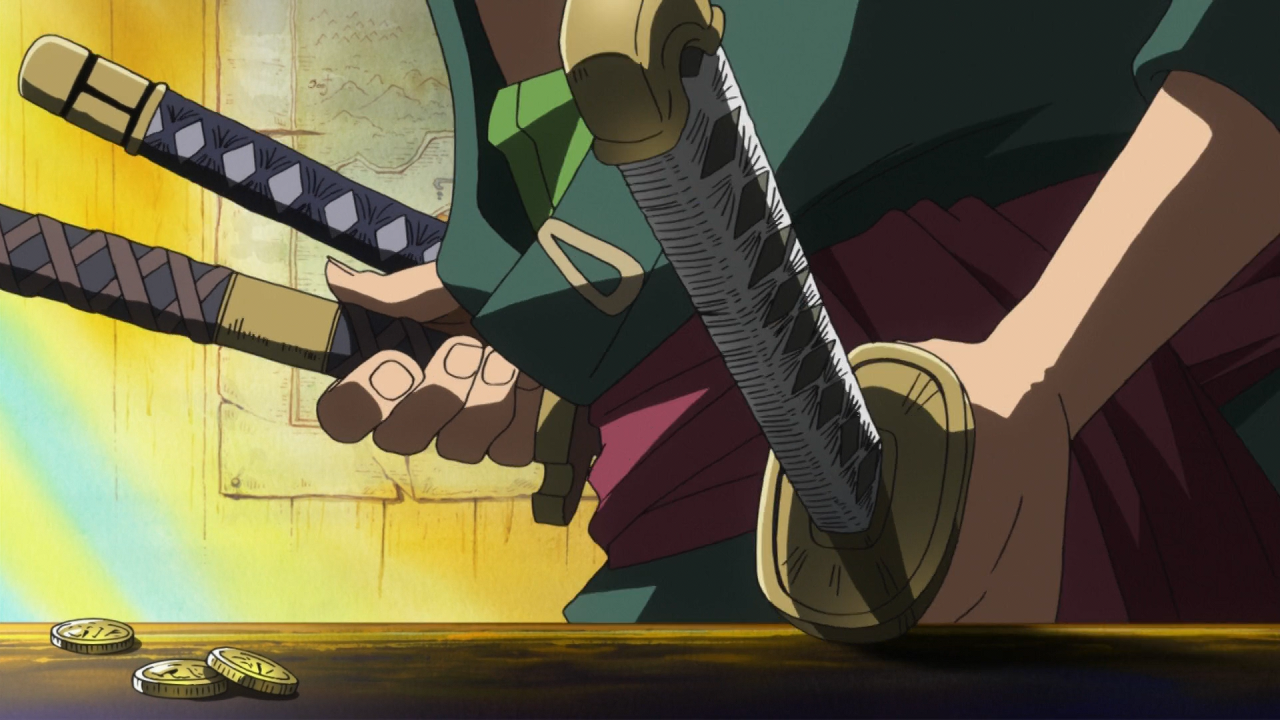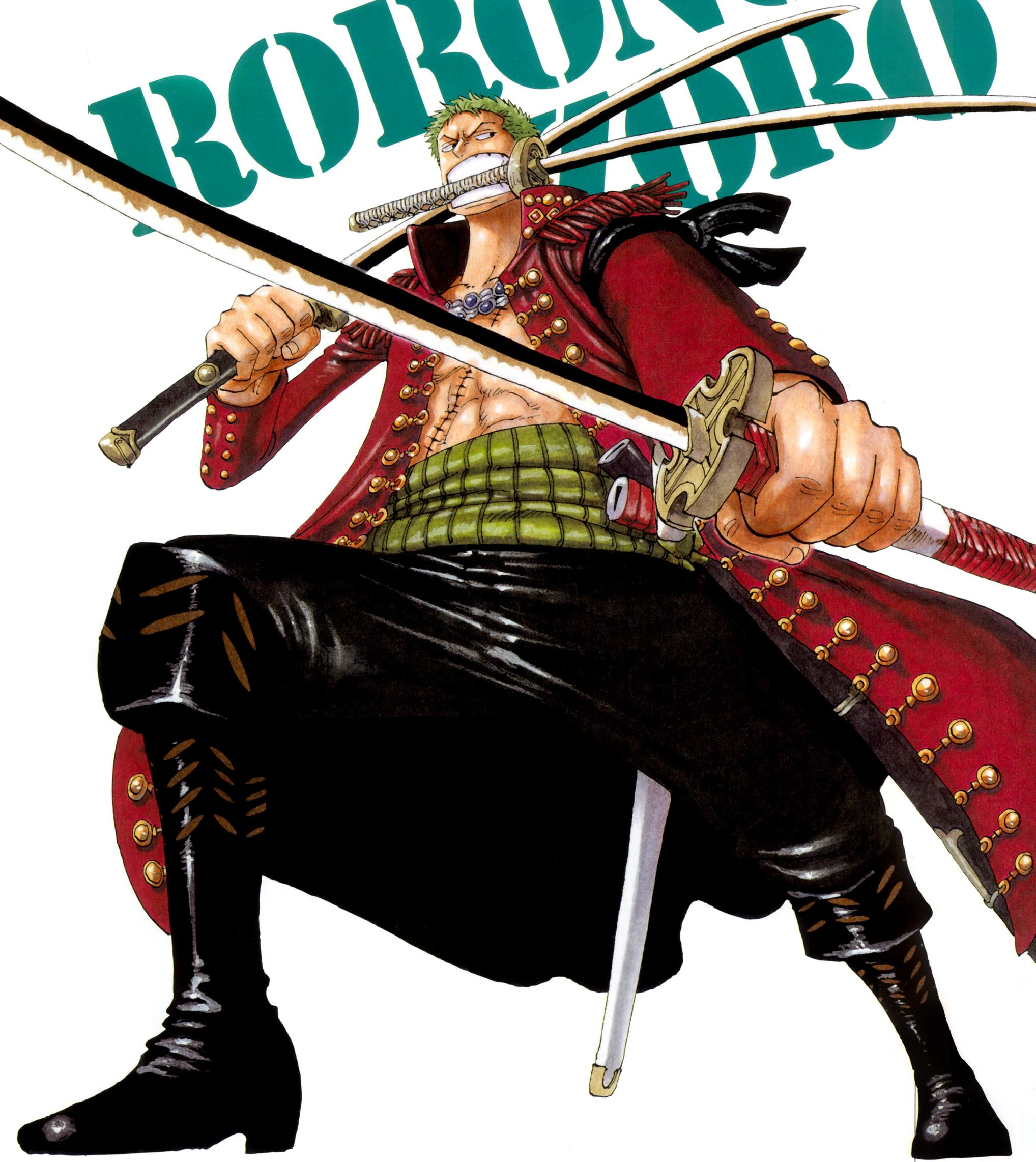Zolo’s Swords
I’ve been thinking a lot about One Piece recently, the mechanics of its storytelling and world-building, and what might be learned from it for games. Without either requiring an audience to read One Piece or spoiling anything major if they do, I think Zolo’s swords offer a useful illustration of some of these techniques.
 Image ©️ Eiichiro Oda or Toei Animation or smth, idk.
Image ©️ Eiichiro Oda or Toei Animation or smth, idk.
Roronoa Zolo is a swordsman of the three-sword style (one in each hand and a third in his teeth), so he usually has three swords on him and losing one limits his fighting power. He goes through many swords over the course of the series, giving them a lot of narrative utility.
Zolo starts with his swords
Zolo starts with two nameless swords and Wadō Ichimonji, one of the 21 “great grade” swords. I will talk in later points about what makes this exciting, but what’s important here is that it is, and that One Piece never shies away from letting characters have cool stuff. Wadō Ichimonji is also slowly woven into several other plots as the story progresses: at first it’s a family heirloom of Zolo’s childhood friend, but later it also becomes the target of a sword collector and evidence of its creator’s exile from their homeland.
In addition to the obvious lesson (“give the players cool toys”), this gradual expansion of its role could be a useful template for integrating stakes in a long-running campaign. Zolo, for example, doesn’t realize that his sword is named until an expert notices it. I think this would require some player buy-in, but could keep “old” abilities and equipment relevant to some degree.
Cool swords are named
This is a classic “make treasure cool” tactic, but it’s used to good effect here. The names of Zolo’s swords give them flavor and history, tying them to specific swordsmiths and previous wielders. Anything named can be spoken about by third parties, which lets the named thing affect the plot even when it’s not present.
All the graded swords are enumerated
Of each “grade” there are a limited number of known swords of that quality. In general, One Piece uses enumeration to build drama and make keep special things scarce. It takes no commitment on the GM’s part to name a player’s sword, but if it’s one of only 12 “supreme grade” swords, it’s a treasure regardless due to the implied scarcity.1 By “drama” I simply mean that numbers make things impressive, either large or small. “The Seven Warlords of the Sea” sounds impressive for its exclusivity and the “Billions” of Baroque Works sound intimidating for their quantity.
This may be incompatible with a gold-for-XP or strictly treasure-seeking play style, as value may quickly outstrip utility.
The grades are ranked
One Piece uses hierarchy in a similar way to enumeration, but additionally to build momentum and communicate relative power. Momentum comes from the knowledge that a finished battle foreshadows another. “If we just defeated someone named ‘Mr. 9’, then we can expect to see enemies № 8-1 in the future.2” Relative power is knowing “we should expect those fights to be tougher than this one was.”
In this way, a “Supreme Grade” sword is more impressive than a “Skillful Grade” sword (and returning to enumeration, you can tell because there are only 12 of the former and 50 of the latter).
Curses are good, actually
Zolo’s swords Kitetsu III and later Enma are both “cursed,” and this is an advantage. After all, a cursed sword is dangerous, and a dangerous sword is a better weapon. Luffy’s abilities can be thought of similarly, which were gained at the cost of some vampire-like weaknesses (the ocean and certain stones can drain his will to live). In a game, especially relying on foreground growth, the abilities gained can be net beneficial, even if they’re presented as a curse. I think it’s easy to forget this, for example when rolling on a mutation table.
Power can grow
Speaking of foreground growth, through use over time by a master, any blade of sufficient quality can eventually be turned into a “black blade,” improving its ranking. This is good for when a character’s improvement over time may assume the accumulation of better weapons and armor, instead of spells or abilities, and I’ve seen some systems that address this.
This also raises a practical difficulty that I’ve been avoiding until now: if the players start with all the best stuff, wouldn’t they know it? One Piece has the advantage over a TTRPG here because Zolo never has to know what his attack bonus is. We can start by assigning some non-combat advantages to a sword: relative indestructibility, for example. But we can also go back on this premise a little by gating their full power behind character advancement.
All things are destructible
One Piece differs from most TTRPGs in that the stakes are almost never “survival of the main characters.” But sometimes things and people that seem permanent become collateral damage. We see this when Zolo’s sword Yubashiri is rusted by Shu (effectively a human rust monster), and it keeps the stakes high. It also gives Zolo a chance to “upgrade” to a different sword later, so this could be considered an act of “creative destruction.”
I think keeping track of creative handicaps and ways for things to get worse is always admirable and should be encouraged. And, similar to how curses can be good, actually, these setbacks provide the opportunity to ultimately be in a better position.
Zolo looks silly
It’s a truism in One Piece that no character is ever “full badass,” and Zolo exemplifies this. Of all the straw hats, he should be the edgelord Sasuke to Luffy’s goofball Naruto. But at the end of the day, he’s holding a sword in his mouth, and that’s kind of dumb. This is a great strength of One Piece: it drives home the unique abilities and weaknesses of each character in any matchup and maintains interest. Without this eccentricity any character’s relative power might just be determined by the height of their hair and the number of senzu beans in their pocket.
 Image ©️ Eiichiro Oda or Shuieisha or smth, idk.
Image ©️ Eiichiro Oda or Shuieisha or smth, idk.
The scarcity here can be an illusion. We haven’t seen all 12 supreme grade swords, and I doubt we will (although I don’t doubt that Oda has sketched them all in his notes). Even in the longest campaign, I could give one to each “boss” or whatever, and I doubt we’d get through all of them.↩︎
This is a maximum likelihood estimate, of course. By contrast, a frequentist analysis leads us to also expect enemies № 10-17.↩︎